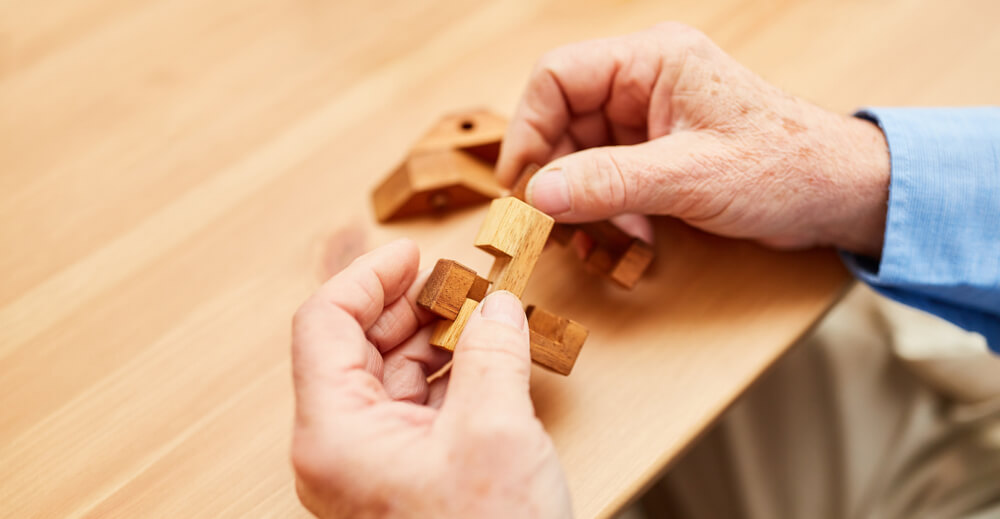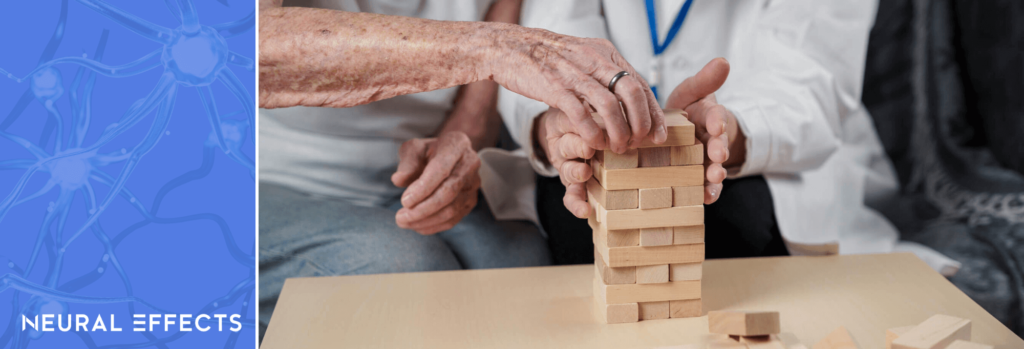Being diagnosed with dementia is never easy. While there is no cure for dementia, there are many strategies families can embrace to slow the decline and help patients live as comfortably and meaningfully as possible.
Treatment can include a combination of pharmacological and non-pharmacological options. In this article, we discuss the most common dementia medications, therapy types, and beneficial at-home changes (such as engaging in regular exercise, following a healthy diet, challenging your brain, and keeping socially active).
The aim of these interventions changes as the disease progresses. For patients with mild cognitive impairment (MCI) or early dementia, interventions are designed to slow down the progression of symptoms and allow the patient to maintain independence for longer. As symptoms get worse and patients need more care, the goal of these interventions shifts to ensuring the patient is comfortable and enjoying the highest possible quality of life.
Neural Effects uses the latest evidence-based techniques to diagnose and help dementia patients. We are located in Provo, Utah and serve anyone in Salt Lake City or the Utah Valley area. We are in network for most types of medical insurance. Schedule your evaluation today.
Pharmacological Interventions

Currently, no prescription drug can cure Alzheimer’s disease, vascular dementia, frontotemporal dementia, Parkinson’s disease, Lewy Body dementia, or any other type of dementia. However, there are medicines that can ease symptoms for a while and slow down disease progression in some patients.
These drugs are only beneficial in the short term (often one to two years) and may be associated with multiple side effects. Overall, medication can be an important part of dementia health care for some patients, but it should not be considered the only way to address symptoms.
Any patients on dementia medication need regular follow-up appointments with the prescribing physician to make sure the benefit is greater than the side effects.
Intervention 1: Drugs to Stop Disease Progression
At the moment, there is only one drug in this category: Aducanumab (Aduhelm).
This drug targets beta-amyloid protein fragments that form in the brain of patients with Alzheimer’s disease. These fragments accumulate into plaques, which then trigger an inflammatory response in the brain and disrupt communication between nerve cells.
The idea behind Aducanumab is that removing these beta-amyloid plaques could stop the cognitive and functional decline experienced by patients. Results from early clinical trials confirm that this drug can decrease amyloid deposition; unfortunately, these studies have not demonstrated that amyloid removal results in any significant cognitive improvements. In addition, some patients also experienced side effects such as swelling and bleeding in the brain, headaches, dizziness, nausea, confusion, and vision changes.
After analyzing these results, an independent advisory committee voted against approval, but the FDA approved it regardless. This decision has been heavily criticized by the medical community, with many health professionals refusing to prescribe Aducanumab to their patients.
Intervention 2: Drugs to Treat Symptoms
As dementia progresses, cognitive skills decline. The drugs in this category cannot stop the damage caused to brain cells by dementia, but they can help slow down the progression of the disease for a while by adjusting the concentration of certain chemicals involved in the way brain cells communicate with each other.
Cholinesterase Inhibitors (Aricept, Exelon, Razadyne)
Dementia patients have lower levels of a chemical called acetylcholine in their brains. This chemical is important because it helps the brain send messages between nerve cells. These drugs stop an enzyme called acetylcholinesterase from breaking down acetylcholine. The resulting higher concentrations of acetylcholine may result in better communication between nerve cells. In practical terms, patients see improvements in memory, thinking, language, judgment, and decision-making.
The cholinesterase inhibitors most commonly prescribed are:
- Donepezil (Aricept): Used to treat all stages of Alzheimer’s disease
- Rivastigmine (Exelon) and Galantamine (Razadyne): Used to treat mild to moderate Alzheimer’s disease
These drugs are generally well tolerated, but they may cause side effects such as nausea, vomiting, loss of appetite, and increased frequency of bowel movements.
Glutamate Regulators (Namenda, Namzaric)
Glutamate is another chemical that helps the brain send messages between nerve cells. In dementia, as nerve cells are dying, they release too much glutamate, which causes problems for the patients. Glutamate regulators can protect surviving nerve cells by blocking the effects of excessive glutamate.
These drugs are usually prescribed to improve memory, attention, reasoning, and language. In addition to patients with Alzheimer’s disease, there’s some evidence that these meds can also help patients with Lewy bodies dementia, vascular dementia, and mixed dementia.
The two types of drugs in this group include:
- Memantine (Namenda): Used to treat moderate to severe Alzheimer’s disease
- Donepezil and Memantine (Namzaric):Combination of a cholinesterase inhibitor and a glutamate regulator used to treat moderate to severe Alzheimer’s disease
Possible side effects include headaches, nausea, vomiting, loss of appetite, constipation, increased frequency of bowel movements, confusion, and dizziness.
Intervention 3: Drugs to Treat Challenging Behavior
When patients reach the later stages of dementia, many develop emotional and psychological symptoms, including agitation, aggression, and hallucinations. These changes can be very distressing, both for the patient and their caregivers.
For extreme or persistent cases, doctors may prescribe antipsychotic drugs such as risperidone or haloperidol. These should be prescribed at the lowest possible dose and only for short periods to avoid side effects. Ultimately, the decision to start and stop antipsychotics should be guided by a psychiatrist with experience in treating older people with neurological conditions. Usually, these medications should only be recommended as a last resort.
Non-Pharmacological Interventions

In addition to pharmacological interventions, there are also many therapies available to address different dementia symptoms. Some can be adapted as the illness progresses and symptoms deteriorate, while others are more suited to specific stages of the condition.
Intervention 4: Physical Therapy (Physiotherapy)
Physical therapy is an ideal tool to help dementia patients. Therapists work closely with patients and their carers to encourage physical activity and to help them maintain their independence for as long as possible. Multiple studies show physical therapy can have positive effects on both cognitive and physical skills in patients with MCI and dementia.
Benefits associated with physical therapy include:
- Lower risk of falls
- Better ability to perform daily tasks
- Increased muscle strength and balance
- Improved quality of life
- Increased social interactions
- Improved mood
- Reduced fatigue and pain
- Better sleep
- Reduced caregiver burden
As the dementia progresses, physical therapists can make adaptations to the therapy routine to accommodate the patient’s changing needs.
Further reading:
Intervention 5: Occupational Therapy
The role of an occupational therapist is to work with dementia patients to maximize their independence in their daily activities. In practical terms, occupational therapists support patients by:
- Suggesting exercises to make daily activities, such as getting dressed or eating, easier to achieve
- Assessing and recommending equipment such as mobility aids or support bars for the bathrooms
- Mitigating risk factors for falls
- Supporting patients who want to continue or return to working
- Suggesting ways to control levels of fatigue
- Helping to plan a routine to provide structure and stability
- Leading patients through exercises to support better cognitive function
They may also be able to connect patients with local support groups, both for themselves and for their caregivers.
Further reading: Occupational therapy for dementia patients
Intervention 6: Speech and Language Therapy
Speech and language therapists can address many of the symptoms of dementia. These clinicians can help patients with communication and language symptoms, such as difficulty with attention and focus, voice and speech problems, and difficulty reading. They also assess and treat swallowing difficulties, which often become a problem for geriatric patients in the later stages of the disease.
Through speech and language therapy, patients usually experience improvements in understanding spoken and written language, as well as in expressing their thoughts and ideas.
Intervention 7: Cognitive Stimulation Therapy
Cognitive stimulation therapy (not to be confused with cognitive behavioral therapy) is aimed especially at those with mild to moderate dementia. Typically, it involves participating in group activities designed to help improve memory, problem-solving skills, and language ability. Activities may include discussions, puzzles, crosswords, listening to music, or engaging in arts and crafts projects.
Clinical trials using this type of therapy found significant benefits in memory and language skills such as naming, word finding, and reading comprehension. They also found a boost in confidence and psychological well-being.
Further reading: Memory therapy for dementia patients
Intervention 8: Reminiscence Therapy

During reminiscence therapy, patients remember events and experiences from their past. The aim is to bring back memories, stimulate mental activity, and focus on positive thoughts. Therapists often rely on props, such as videos, music, pictures, and objects that hold a particular meaning for the patient.
It’s easier for patients with mild dementia to participate in reminiscence therapy, but even those with more advanced cases of the disease can still experience the pleasure of looking at old photos or listening to their favorite music.
Possible reminiscence topics include:
- Childhood events
- Favorite playground games/board games
- Foods likes and dislikes
- Pets and animals
- Family and relationships
- Music
- Favorite sports team
Intervention 9: Talk Therapy
Talk therapy — such as cognitive behavior therapy and counseling — involves sessions with a counselor, a psychologist, or a psychiatrist where patients can discuss their feelings and worries, including how they feel about their diagnosis. Patients may find it easier to discuss their problems with a therapist rather than with their loved ones. Several studies show that talk therapy can reduce symptoms of depression and anxiety. This kind of therapy could also include psychosocial interventions.
Talk therapies are effective for older adults in the middle and early stages of dementia, but not for late-stage patients. Patients with late-stage dementia have severe difficulties with attention and communication such that they cannot engage in this type of therapy.
Intervention 10: Massage and Aromatherapy
Massage and aromatherapy can have a calming effect on patients suffering with dementia. Therapists use different essential oils to relieve stress and promote well being. For example, lavender, chamomile, and lemongrass can be used to promote relaxation. In the later stages of the disease, some patients’ sense of smell is reduced, which means this therapy becomes less effective.
Massage and aromatherapy care services aren’t suitable for everyone. For example, it should be avoided when patients have skin conditions such as psoriasis or eczema. In addition, some patients don’t like being touched, which means massage is not the best option for them.
Intervention 11: Art Therapy
Patients with dementia often enjoy being involved in creative activities. This may include sculpting, painting, drawing, making cards, creating jewelry, or participating in community art projects. These activities reduce agitation and boost mood, as well as give patients a sense of accomplishment and purpose by providing an opportunity for nonverbal expression.
Studies show that art therapy boosts cognitive function, enhances communication, and promotes social interaction for dementia patients.
Intervention 12: Music Therapy
Music therapy can be used with dementia patients during all stages of the condition. It can improve behavior problems, lower anxiety, and control agitation.
Patients with early dementia can play a musical instrument, sing, or attend musical concerts, for example. As the disease progresses and starts to affect communication, patients can still enjoy listening to familiar songs and unlocking happy memories from the past. This makes music therapy appropriate for ongoing, long-term care.
Therapists can also teach caregivers to use music to help take care of their loved ones. For example, if you’re trying to help an agitated patient get dressed, playing soothing music or a favorite song can help them calm down enough to accept the help.
Intervention 13: Pet Therapy (Animal-Assisted Therapy)
Pet therapy can be beneficial for patients who had pets but now rarely experience the enjoyment of being close to animals. Petting a cat or a dog can reduce some negative behaviors, such as agitation and aggression, and improve the patient’s mood. It also increases social interactions if done as a group and promotes physical activity for patients who can still go out and play with an animal.
Intervention 14: Reality Orientation Training

Reality orientation training is aimed at patients in the mid to late stages of dementia. It involves repeating basic information, such as the patients’ name, where they live, and the date. The therapist may also refer to clocks and calendars on the wall and suggest placing signs and labels on doors, cupboards, and other objects. This approach doesn’t suit everyone; some patients accept this information, while others find it patronizing.
In a number of studies, this method produced improvements in orientation (when patients can identify the date and time of day), cognition, function, behavior, and social interaction. However, most changes were only temporary.
Intervention 15: Validation Therapy
In simple terms, validation therapy is the opposite of reality orientation training. There is no effort to remind patients about the date or where they live. Instead, care providers engage with patients and work within their reality. For example, if a 90-year-old patient is expecting her mother to come home, the therapist asks questions about her childhood instead of correcting the patient.
Research is mixed about the effectiveness of this therapy. Some studies found that it can decrease agitation in patients and help caregivers feel more positive, while others found no significant benefits.
Intervention 16: Doll Therapy
Dolls can be very useful in dementia care, especially for late-stage patients. Some patients enjoy holding a doll (or a teddy bear) and remembering events from their childhood.
Playing with dolls and other toys can improve the patient’s mood, improve communication, promote social interaction, and reduce the incidence of delirium episodes. Doll therapy can also reduce the use of antipsychotic drugs, prevent wandering, and improve quality of life.
Intervention 17: Sensory Stimulation Therapy (Sensory Integration Therapy)
Sensory stimulation therapy can help dementia patients remember positive emotions and memories. The aim is to trigger one of the five senses — hearing, sight, smell, taste, or touch — by showing the patient everyday objects that mean something.
It can be as simple as cooking their favorite cake or giving them a bouquet of their favorite flowers. In a way, music therapy is also a form of sensory stimulation therapy. The aim is to make patients feel safe and relaxed, as well as to improve their mood, self-esteem, and well-being.
Intervention 18: Bright Light Therapy
Sleep problems and disruptive behavior at night are common in dementia patients. Bright light therapy can be a beneficial treatment for these sleep disturbances. It can improve the patient’s mood and communication skills, as well as reduce symptoms of anxiety and depression.
During a session of bright light therapy, patients sit in front of a light box that provides about 30 times more light than the average light for a set amount of time. The aim is to reset the patient’s internal clock (known as the circadian rhythm), which is often disrupted in dementia patients.
Intervention 19: Combination of Physical and Cognitive Therapies
Many therapies for dementia are administered one at a time. At Neural Effects, we believe using a combination of therapies at the same time can be much more effective. This is supported by many studies, with patients benefiting from completing cognitive therapy immediately after physical exercise.
This combination works because physical exercise triggers a phenomenon called the post-exercise cognitive boost (PECB). This involves the release of an important chemical called brain-derived neurotrophic factor (BDNF). BDNF makes the brain more receptive to change, allowing patients to benefit more from therapy shortly after exercise.
If you visit our clinic, you’ll undergo a neuropsychological exam (also called a neurocognitive evaluation) to find out how dementia has affected your cognitive skills. This exam includes tests to assess memory, attention, and other cognitive skills. The exam is important to take even if you already have a diagnosis of dementia so that our therapists can tailor treatment therapy to your needs and so that we can establish a baseline to reference over time.
Our team will also assess your reflexes, eye movements, balance, posture, and how well your senses are working. The mental health evaluation looks for signs of anxiety, depression, or stress.
After these exams, you and your loved one will meet with a member of our team to discuss possible treatments. This involves a series of therapies such as cognitive therapy, neuromuscular therapy, and occupational therapy.
You can bring a family member to your sessions so that they can learn the exercises and help you at home. At the end of each session, our therapist will also give you exercises to do at home. Completing these exercises is a good way to improve the overall effect of therapy.
All of our staff are trained to help dementia patients and can answer any questions you may have about your diagnosis or treatment. We also keep you informed about new research developments and will share helpful information with your caregivers.
At-home Interventions

For patients with dementia, lifestyle choices and daily habits can have a strong impact on how they feel. In fact, studies show that staying physically and mentally active, as well as following a balanced diet, are some of the most effective interventions to slow down the progression of the disease.
Intervention 20: Stay Physically Active
Staying physically active not only improves fitness and strength, but it also helps patients cope with cognitive symptoms such as thinking problems or memory loss.
Whether it’s attending an aerobic class for seniors, going for a walk, or spending the afternoon gardening, it all counts. The recommendation is to be active for at least 30 minutes every day, five days a week. This can be broken down into multiple sessions throughout the day, with each session lasting a minimum of 10 minutes.
Benefits of regular physical exercise include:
- Improved cardiovascular health
- Improved physical fitness
- Improved ability to perform activities of daily living (ADLs) such as getting dressed, cleaning their home, and cooking meals
- Slowed cognitive decline
- Improved sleep
- Increased opportunities for social interaction
- Reduced risk of falls
- Improved confidence and self-esteem
- Improved mood
Intervention 21: Follow a Balanced Diet
For a patient with dementia, poor nutrition may increase behavioral symptoms and cause weight loss. In contrast, good eating habits can slow down the progression of the disease. One example of a balanced diet is the MIND diet, combining a traditional Mediterranean diet and the DASH diet (designed to lower high blood pressure). Studies show this diet can slow down brain aging at the equivalent of 7.5 years.
The MIND diet includes eating vegetables, fruits, nuts, whole grains, low-fat dairy products, and lean protein foods while avoiding salty, sugary, and fatty processed foods.
Intervention 22: Challenge the Brain
Alongside regular physical activity and following a healthy diet, staying mentally active and challenging your brain on a daily basis is one of the best ways to slow down the progression of dementia symptoms.
It’s important not to pick an activity that is going to frustrate the patient because they can no longer do it. Instead, it needs to be an activity that the patient can enjoy. Anything that can help patients think quickly, recall information, or make decisions can improve cognitive function.
Examples include:
- Playing games and puzzles
- Learning a new skill, such as how to play a musical instrument
- Reading
- Using apps for brain games
- Rekindling an old hobby or finding a new one
- Engaging in activities that require coordination, such as arts and crafts
Intervention 23: Keep Socially Active

It’s easy for dementia patients to lose contact with friends and isolate themselves at home. This is a worrying behavior as it accelerates the progression of the disease and increases the chances of developing anxiety and depression.
Patients should make an effort to stay socially active. For example, joining an art club, volunteering for a local charity, or going out with friends are all good ways to keep in touch with others. For patients who struggle with mobility, even just phoning their loved ones for a regular chat can help. Some care settings, such as nursing homes, provide activities that encourage their residents to socialize regularly.
Reminiscing about past events or discussing what’s happening in the world can help patients protect their memory and communication skills. Even patients with late-stage dementia who have difficulty communicating should be included in family events to allow them to interact with others.
Intervention 24: Establish a Good Sleep Pattern
Many dementia patients experience problems sleeping. This includes difficulty falling asleep at night, followed by drowsiness during the day. Some patients with dementia also experience a phenomenon in the evening called sundowning, where they feel confused, agitated, anxious, and aggressive as it gets dark.
To promote better sleep:
- Check for medical conditions, such as depression or sleep apnea, which may cause sleep problems.
- Always follow a routine by going to bed and getting up at the same time.
- Avoid alcohol and caffeinated drinks, especially at night.
- Avoid the use of screens before going to bed.
- Get some physical activity during the day. This can help promote better sleep at night.
- Limit daytime naps to 20-30 minutes.
- Create a peaceful mood before going to bed. Find a relaxing activity such as listening to calming music or reading a book.
- Check medication side effects. Some medications — including donepezil, for example — can cause insomnia. Taking these earlier in the day may help, but check with your doctor before you make any changes.
- Consider taking melatonin. Melatonin can help improve sleep and reduce sundowning in people with dementia.
Neural Effects uses the latest evidence-based techniques to diagnose and help dementia patients. We are located in Provo, Utah and serve anyone in Salt Lake City or the Utah Valley area. We are in network for most types of medical insurance. Schedule your evaluation today.
